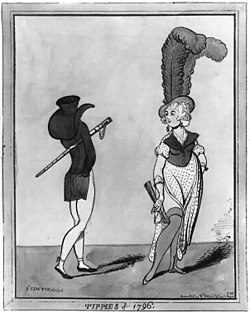
Exaggeration is the representation of something as more extreme or dramatic than it is, intentionally or unintentionally. It can be a rhetorical device or figure of speech, used to evoke strong feelings or to create a strong impression.
Amplifying achievements, obstacles and problems to seek attention is an everyday occurrence[1] Inflating the difficulty of achieving a goal after attaining it, can be used to bolster self-esteem.[2]
In the arts, exaggerations are used to create emphasis or effect. As a literary device, exaggerations are often used in poetry, and is frequently encountered in casual speech.[3] Many times the usages of hyperbole describes something as better or worse than it really is. [4] An example of hyperbole is: "The bag weighed a ton."[5] Hyperbole makes the point that the bag was very heavy, though it probably does not weigh a ton.[6]
Exaggerating is also a type of deception,[7] as well as a means of malingering – magnifying small injuries or discomforts as an excuse to avoid responsibilities.[8]
- ^ Daniel Goleman, Emotional Intelligence (London 1996) p. 113.
- ^ Beth Azar "All puffed up" Monitor on Psychology, June 2007, Vol 38, No. 6.
- ^ "Definition of Hyperbole". Retrieved 10 January 2014.
- ^ "Definition of HYPERBOLE". www.merriam-webster.com.
- ^ Mahony, David (2003). Literacy Tests Year 7. Pascal Press. p. 82. ISBN 978-1877085369.
- ^ "Hyperbole". Byu.edu. Retrieved 10 January 2014.
- ^ Guerrero, L., Anderson, P., Afifi, W. (2007). Close Encounters: Communication in Relationships (2nd ed.). Los Angeles: Sage Publications.
- ^ R. Rogers Clinical Assessment of Malingering and Deception 3rd Edition, Guilford, 2008. ISBN 1593856997
